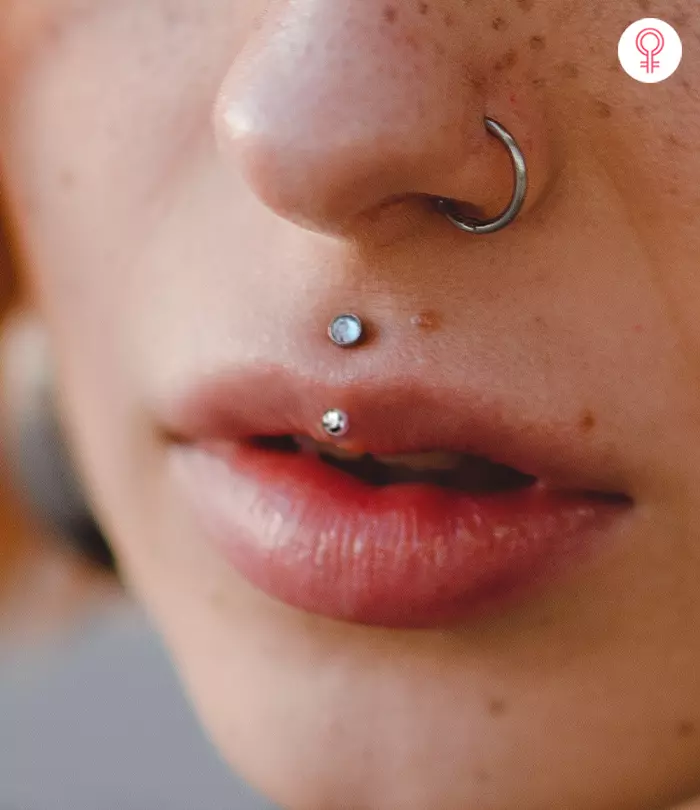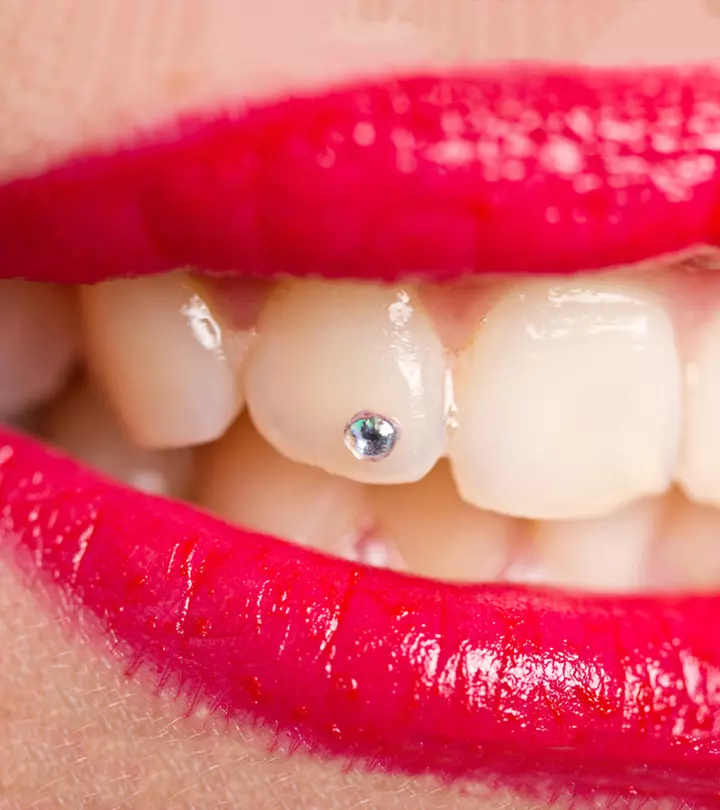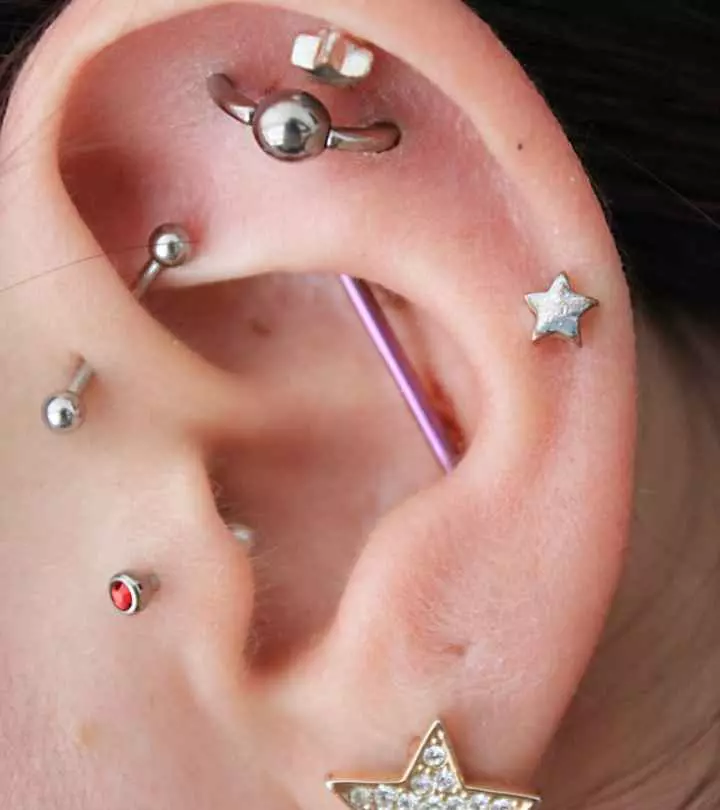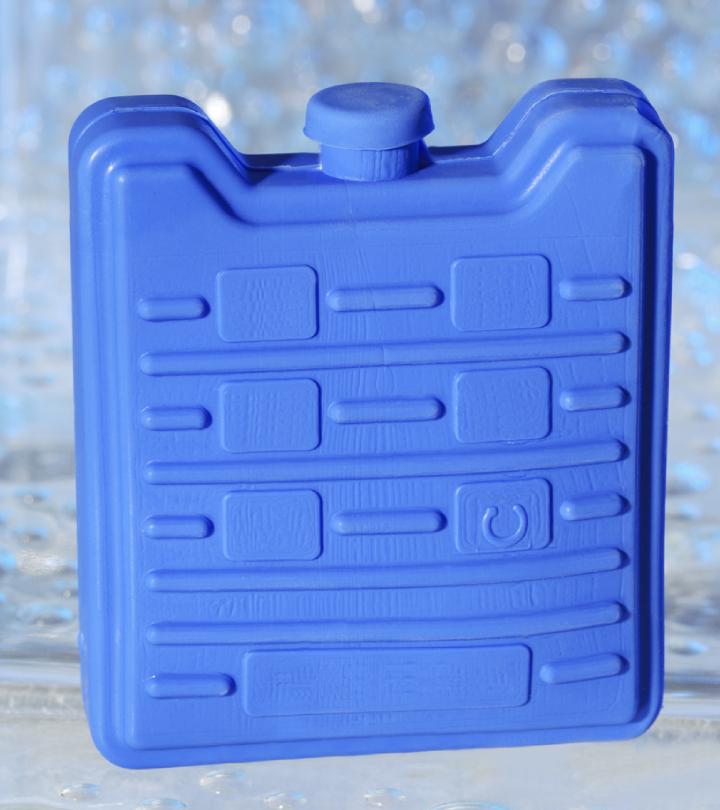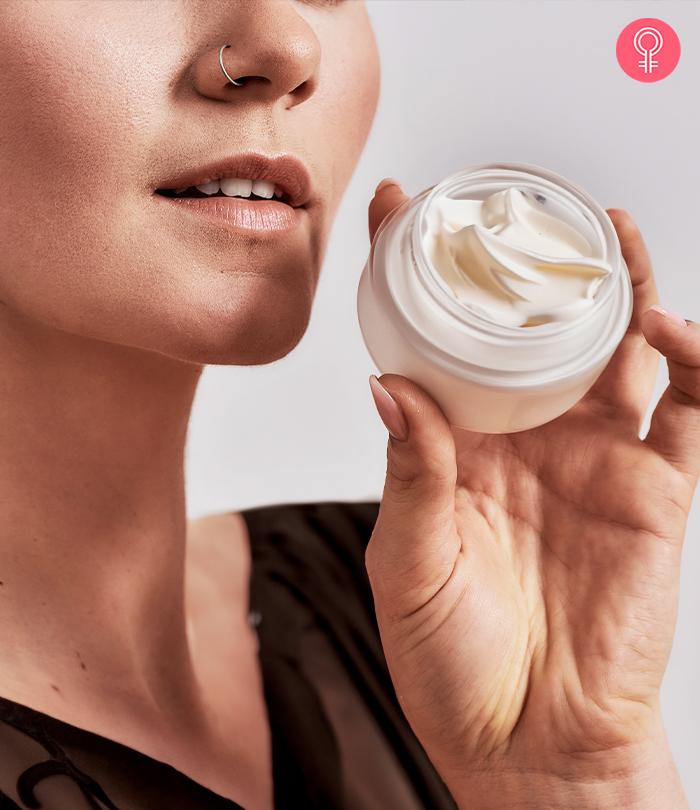Medusa Piercing: Process, Healing Time, And Aftercare
Elevate your style and femininity with Medusa marvel where confidence shines.

Image: Shutterstock
A Medusa piercing, also known as philtrum piercing, draws attention to the lips by giving you the ultimate bold look. Planted right above your upper lip, this piercing lets you express yourself with an edgy touch. Getting a Medusa piercing is a bold expression of uniqueness and self-assurance rather than just a fashion choice. However, as with any piercing, it may cause sharp pain and requires proper aftercare and hygiene to ensure a smooth and successful healing process. In this article, we discuss everything about a medusa piercing, from where it gets its name and the piercing process to healing and aftercare measures and tips for choosing the right piece of jewelry. Scroll down to keep reading!
 Piercing Guide: Medusa Piercing
Piercing Guide: Medusa Piercing- Placement: Through the center of the cupid’s bow, below the septum
- Best Jewelry: Flat back studs, dropper studs, circular barbell
- Cost: $30 to $90
- Pain Level: Moderate
- Healing Time: 6 to 12 weeks
In This Article
Medusa Piercing: Meaning And What It Is
A Medusa piercing, also known as philtrum piercing, is achieved by puncturing the thin strip of skin in the middle of the upper lip, right above the cupid’s bow, and is usually adorned by a labret stud. One end of the jewelry is placed inside the mouth, while the other is placed outside, perpendicular to the lip. While the significance of this upper lip piercing can be personal, it is generally worn as a symbol of confidence or to enhance one’s facial features. The philtrum is the vertical bridge between the middle base of the nose and the upper lip.
This is what Medusa piercing is and its meaning. Find out the origin behind why it is referred to as a Medusa piercing in the next section.
Why Is It Called A Medusa Piercing?
The Medusa piercing is a term derived from the Greek mythology character Medusa, renowned for her snake-like hair. The middle of the top lip, where the piercing is situated, is said to symbolize the place where Medusa was kissed before she died. But there is no clear correlation between the piercing and the mythological figure. Some say that the piercing was named after her because, just like her beauty, it catches everyone’s eye.
The term is a creative and symbolic choice made for artistic and aesthetic reasons to describe a particular type of lip piercing. In fact, rumor has it that in the 90s, a Canadian hairdresser gave this piercing the name Medusa simply because its original name was too long and anatomical.
 Trivia
TriviaGiven that its name is also philtrum, you must be wondering whether this piercing is extremely painful or not. Learn more about it n the section below.
Is Getting A Medusa Piercing Painful?
View this post on Instagram
The pain experienced during a Medusa piercing can vary from person to person. The subjective nature of pain perception is dependent upon an individual’s pain threshold. Generally, the Medusa piercing is considered to be moderately painful. The piercing goes through the philtrum which contains blood vessels and nerve endings, so you can expect some discomfort during the actual piercing process. The pain is typically quick and may feel like a sharp pinch followed by some redness and swelling. However, once the pierced skin starts healing, these symptoms should subside. The piercer’s expertise, the person’s pain threshold, and proper aftercare are all factors that can affect the degree of pain.
Sian, a blogger, shares her Medusa piercing experience in a personal blog. She writes, “For those who are worried about swelling… mine swelled up, a LOT. I had work the next day and people honestly thought I had had lip fillers. They said it looked good, though. My swelling was there for about a week, though it stayed slightly swollen for a few weeks after that (i).”
To properly understand how painful a medusa piercing can be, you need to get educated on the piercing process itself. Start by analyzing the procedure in the next section.
Medusa Piercing Process: What To Expect
View this post on Instagram
Here is an outline of the typical procedure involved in getting a Medusa piercing:
- Choose a reputable and skilled piercer with years of experience giving facial piercings who follows the highest hygienic practices. Seek out studios that follow stringent safety and hygienic regulations. Also, ensure that the tools are removed from their sterilized pouches right in front of you.
- Have a consultation with a professional piercer before getting your piercing. In this session, they will go over details such as the piercing process and placement, available jewelry choices, and aftercare instructions. They will also address any concerns or questions you may have.
- The experienced piercer will sanitize and disinfect the region surrounding your upper lip as well as the piercing tools to prevent infections.
- The piercing expert will then mark the placement of the piercing on the upper lip. With this step, prior to the piercing, you can verify the positioning and ensure accuracy with this procedure.
- The piercer will use a hollow, sterile needle to make the hole at the philtrum. Though it is a short procedure, you will feel a sharp pinch. For added security during the piercing, some piercers may grasp the lip with forceps to hold the area in place during the piercing.
- After the hole is created, the piercer will insert the chosen jewelry, usually an initial labret stud with a 6 mm length and 1.2 mm thickness, into the piercing. Then, screwing this lip piercing stud into the flat-backed stem secures the decorative head, usually a 4 mm gem or pin.
- Finally, your piercer will clean up the area and stop any bleeding by using pressure and saline.
After delving into the details of the Medusa piercing procedure, it is time to turn our attention to the important healing and aftercare phase that ensures your new piercing is healthy and clear of infections. Scroll down to find out the healing and aftercare measures of Medusa piercing in the next section.
Medusa Piercing: Healing And Aftercare
View this post on Instagram
Healing Process
A thorough and comfortable healing process is essential for the aftercare of a Medusa piercing.
- In general, it can take 6-8 weeks for most lip piercings to recover (1).
- The speed and extent of your healing may be influenced by how well you take care of your piercing.
- Following a piercing, the healing process may involve some soreness, bruising, initial swelling, and little bleeding.
- Additionally, it is possible for the wound to secrete a small amount of white lymphatic fluid, which is not pus.
Aftercare Tips
After around one to two weeks, the swelling will totally go down, and the piercer should replace the labret stud with a smaller one. Here are some ways to take care of your piercing:
- Use a mild, non-alcoholic antiseptic solution, mouthwash, or saline solution to clean the piercing (1). Gently wipe away any dried discharge from the area surrounding the piercing using a cotton swab.
- Avoid using dirty hands to touch the piercing in order to prevent the spreading of bacteria.
- Brush your teeth regularly to maintain good oral hygiene, but be careful around the piercing.
- Steer clear of alcohol, tobacco, and spicy foods since they can aggravate the piercing (1).
- Exercise caution when eating, talking, or doing other activities where the piercing can come into touch.
- During the first stages of recovery, refrain from any oral contact, including kissing (1).
- If there is swelling, consider using a clean, cold compress to minimize it.
- Avoid unnecessary movement of the jewelry to promote proper healing.
- Till the piercing is completely healed, keep it out of the water in places like lakes, hot tubs, and pools.
- If you see any signs of infection, make an appointment for follow-ups with your piercer and seek professional advice if you notice any signs of infection.
 Pro Tip
Pro TipThese are some effective aftercare steps to be considered for a successful piercing experience. But how do you clean a Medusa piercing to avoid infections? Scroll down to know in detail.
How To Clean A Medusa Piercing
Cleaning a Medusa piercing is an essential part of the aftercare routine to promote healing and prevent infections. Here is a simple step-by-step guide on how to clean a Medusa piercing:
- Make sure your hands are clean before touching your piercing. Wash them thoroughly with a mild, hypoallergenic cleanser and water.
- Dip a clean cotton ball or Q-tip into the saline solution. Ensure it is moistened without dripping wet.
- Gently clean and remove any crust or debris from the area surrounding the Medusa piercing with care. Do not turn the jewelry around too often.
- Use warm water to rinse the piercing to get rid of any remaining saline solution. Make sure the piercing is kept away from soap and other cleaning supplies.
- Apply a fresh paper towel or tissue to the piercing area and gently pat it dry. Avoid using cloth towels, as they may harbor bacteria.
- Limit cleaning the piercing to 2–3 times a day. Cleaning the piercing too much can irritate the skin and interfere with its natural healing process.
- Avoid using harsh cleaning solutions like hydrogen peroxide, alcohol, or other substances that may inhibit healing as they are excessively abrasive.
- Brushing your teeth after every meal and using an alcohol-free, antibacterial mouthwash help prevent bacteria build-up, reducing the risk of infections.
It is essential to learn proper cleaning methods if you want to keep your Medusa piercing looking great. But it is equally important to understand the possible side effects of these piercings to make your piercing hassle-free. Find out about the adverse effects of a Medusa piercing in the following section.
Side Effects Of A Medusa Piercing
View this post on Instagram
A Medusa piercing comes with some adverse effects, just like any other piercing, both during and after the healing period. Here are some common side effects associated with a Medusa piercing:
- Scarring
All types of piercings, including Medusa piercings, have a risk of scarring. Individual healing processes, aftercare routines, and difficulties during the healing phase are some of the factors that affect how much scarring a person experiences. Some individuals may be prone to developing keloids that are elevated scar tissue growths (2). Medusa piercings are considered more likely to cause hypertrophic scars. These scars occur due to an overproduction of collagen during the healing process and are usually treatable with the right aftercare and maintenance.
If the screw or any part of the jewelry is not properly fitted or if it has sharp edges, it may catch on the sensitive tissue inside the mouth, causing discomfort or irritation and even cuts and scarring. So it is important to make sure the jewelry is made to fit well, has clean edges, and is fastened securely to avoid any issues.
- Infection
Most piercings have the risk of an infection post-procedure, including lip piercings (3). Medusa piercing infections may result from poor hygiene, the use of infected jewelry or materials, trauma or excessive movement, low-quality jewelry, oral contact, environmental exposure, and weakened immune systems. Excessive swelling around the piercing site, persistent or worsening pain, and redness may indicate a risk of infection. Additionally, the area around the infected Medusa piercing may feel warmer than the surrounding skin. It is typical to have some early swelling, but it should eventually go down. However, if you notice green, yellow, or foul-smelling discharge, it is a clear sign of infection. Clear or light-colored discharge is possible in healthy piercings. In severe cases, an infection may lead to systemic symptoms such as fever. Additionally, there is also the complication of a gingival recession (3). If you notice any of these symptoms, consult a doctor immediately, as they can prescribe the needed medication to reduce the infection and speed up the healing process. However, oral piercings are said to have a lower infection rate and can be treated with antibiotic medication such as amoxicillin/clavulanate (4).
In addition, if a Medusa piercing comes into contact with the gums or teeth, it may lead to gum recession or injury to the teeth.
These are some potential side effects of Medusa piercing. Proper cleaning of Medusa piercing is important to prevent infections and speed up the healing time. But how much does this piercing procedure cost? Scroll down to know in detail.
How Much Does A Medusa Piercing Cost?
The cost of a Medusa piercing may vary based on a number of variables, such as the piercer’s experience level, the quality of the jewelry used, and the location and reputation of the piercing studio. It is undeniable that the piercer’s experience and skill level may have an effect on the piercing’s price. Piercers with a lot of experience and a solid reputation may charge more for their services. Popular and busy piercers may choose to set their prices higher due to demand and limited availability. In addition, take into account the kind of jewelry you want as well, as better materials may cost more. But, the price generally ranges from $30 to $90 or more.
Choosing the right jewelry type for Medusa piercing is important to ensure comfort and safety. Scroll down to learn more about Medusa piercing jewelry.
Medusa Piercing Jewelry: Types And Materials
Opt for high-quality materials that are less prone to irritate the skin. Always choose materials that are less likely to trigger allergic reactions. It is recommended to avoid nickel jewelry, as it is a well-known allergen. Here are some common types of Medusa piercing jewelry.
Types Of Medusa Piercing Jewelry
- Labret Studs
View this post on Instagram
A common option for Medusa piercings is labret studs. They are made up of a straight bar with a flat back plate and a decorative top that may have the shape of a gemstone, ball, or other pattern.
- Flatback Labret
View this post on Instagram
The flatback labret is a variant of the classic labret stud, with a disc or flat back in place of the traditional ball. Inside-of-the-mouth irritation and pain are reduced by this design.
- Dropper Studs
View this post on Instagram
Dropper studs or dangling pieces of jewelry have decorative components hanging down from the main section of it for people who want to add a little more flair.
- Circular Barbell
View this post on Instagram
A circular barbell is a jewelry item in the shape of a horseshoe that screws into both ends of the bar and has threaded balls or decorative ends.
- Threadless Jewelry
View this post on Instagram
With threadless jewelry, changing the decorative toppers is simple and does not need taking the entire piece off because the post and decorative end are held together by tension.
What Jewelry Material Is Used For Medusa Piercing?
Here are some of the commonly used materials for Medusa piercing jewelry (5):
- Implant-grade Titanium: Titanium specifically made to satisfy particular requirements for usage in body piercings and medical implants is known as implant-grade titanium. It is a popular material for body jewelry as it is hypoallergenic, lightweight, and resistant to corrosion.
- Surgical Stainless Steel: Surgical steel, sometimes referred to as surgical stainless steel, is often used for body jewelry. It’s inexpensive, corrosion-resistant, and long-lasting.
- Solid Gold: For body jewelry, especially Medusa piercings, solid gold is a luxurious and visually appealing choice. However, selecting fine gold is essential to prevent any possible skin reactions.
You have to be extremely cautious while handling the piercing jewelry. Once the tissues on the piercing area heal, you may change the jewelry. Scroll down to learn more about the process.
How To Change Medusa Piercing Jewelry
- Use a gentle, fragrance-free soap to clean the piercing and its surroundings, and make sure the new jewelry is clear and clean.
- Holding both ends firmly, carefully remove the existing jewelry.
- Make sure the new jewelry is firmly in place by inserting it from the back to the front.
- Using a cotton ball or swab soaked in saline solution, clean the piercing region to get rid of any extra crust.
- Reclean the area and, if in doubt, get expert assistance. Continue frequent aftercare to ensure the best possible healing.
The following tips may help you choose the right jewelry for your piercing. Scroll down to learn.
Tips To Choose Medusa Piercing Jewelry And Material
- If you have known allergies to certain metals, such as nickel, be cautious about selecting jewelry made from those materials (6). Additionally, using low-quality jewelry finished with silver or gold coating that wears off easily may lead to allergy sensitivity and delay the healing process (5).
- Select jewelry in the size and design that best complements your features and defines your style. Typically, flat-back studs with a decorative top or labret studs are used in Medusa piercings. Make sure that the jewelry is not too large or too little for your anatomy.
- Make sure the gemstones or other decorative pieces are firmly fixed so they will not catch on clothes or create discomfort if you decide to wear them on your jewelry.
- Choose jewelry that is easy to clean to practice proper hygiene. Cleaning can prevent the growth of bacteria if surfaces are smooth and have few gaps.
- Ensure the screw that holds the jewelry in place is not too big or sharp since it will be placed within the mouth, near thin delicate skin.
Medusa piercing is a symbol of a bold fashion statement that grooves above the cupid’s-bow of the lip. But for a smooth and successful piercing experience, having a skilled piercing expert is key. Practicing proper aftercare measures and maintaining good oral habits may help in quick healing and also prevent infections. However, if you experience any discomfort, it is recommended to consult a professional.
Frequently Asked Questions
How to take out the Medusa piercing?
To safely remove a Medusa piercing, soak it in saline solution, make sure it is clean, and look for any indications of infection before carefully sliding the jewelry out by unscrewing the back. If you encounter any difficulties, then seek professional help to minimize complications.
When can I change my Medusa piercing?
It is usually recommended to replace a Medusa piercing, or any other facial piercing, following the initial healing phase, which usually takes 6 to 12 weeks.
What gauge is a Medusa piercing?
The standard gauge for Medusa piercing is commonly 14 or 16 gauge. However, sizes may differ, and people may select various gauges according to piercer recommendations or personal taste.
Key Takeaways
- A Medusa piercing is done above the lip on the bridge under the nose. It has a medium pain level, unless you have a really strong pain threshold.
- Choosing a professional and skilled piercer is important to ensure a safe and successful piercing experience.
- Following a proper aftercare practice and choosing the right jewelry help promote healing and prevent infections.
Discover the highs and lows of a swollen lip journey post a Medusa or philtrum piercing. From day one struggles to triumphant moments, this video captures the raw essence of the healing process. Stay tuned for the ultimate lip transformation!
Personal Experience: Source
StyleCraze's articles are interwoven with authentic personal narratives that provide depth and resonance to our content. Below are the sources of the personal accounts referenced in this article.
(i) Piercing: Medusa/Philtrum Pain And Issues
https://sianoddities.blogspot.com/2017/03/piercing-medusaphiltrum-pain-and-issues.html
References
Articles on StyleCraze are backed by verified information from peer-reviewed and academic research papers, reputed organizations, research institutions, and medical associations to ensure accuracy and relevance. Read our editorial policy to learn more.
- Body Piercing
https://youngwomenshealth.org/guides/body-piercing/ - Piercings In Medical Students And Their Effects On The Skin
https://www.researchgate.net/publication/267520788_Piercings_in_medical_students_and_their_effects_on_the_skin - Dental And Oral Complications Of Lip And Tongue Piercing
https://www.researchgate.net/publication/7521289_Dental_and_oral_complications_of_lip_and_tongue_piercing - Body Piercing Infections
https://www.ncbi.nlm.nih.gov/books/NBK537336/#:~:text=Conservative%20treatment%20of%20minor%20local - Oral Piercings- Pain Or Pleasure?
https://journals.indexcopernicus.com/api/file/viewByFileId/928991.pdf - Allergy And Orthodontics
https://www.ncbi.nlm.nih.gov/pmc/articles/PMC4072366/
Read full bio of Anjali Sayee
Read full bio of Shreya Mukherjee





